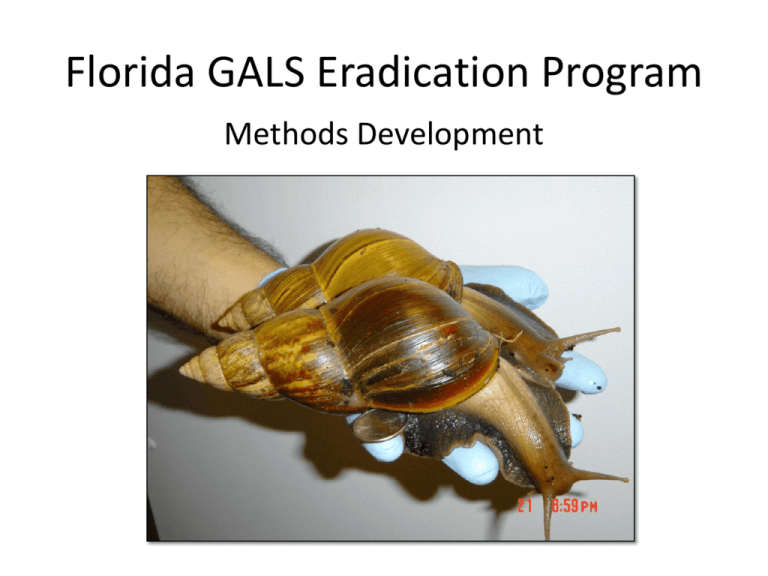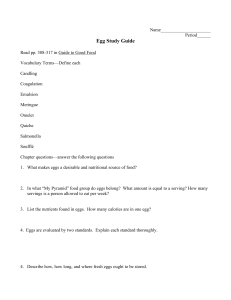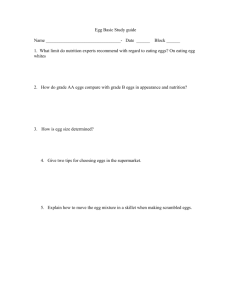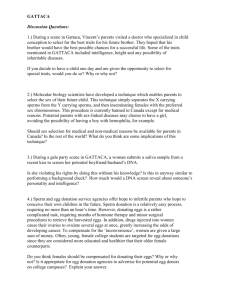Eradication Programs - Amazon Web Services
advertisement

Florida GALS Eradication Program Methods Development Objectives • Chemical Control Techniques – Molluscicide bait efficacy testing – Effective soil drench development • Trap Development – Most effective trap design – Most effective attractants • Nematode Detection – Is Angiostrongylus cantonensis widespread in Florida? • Biological Studies – – – – – Time to reproductive maturity (defined by first egg laying event) Growth rate over time and “natural” survivability Clutch size and frequency of egg laying and effect of burial depth on egg hatch Effect of population density on the animals Source of chirality in A. fulica using traditional crosses and molecular techniques. Molluscicide Evaluation • Kemp, N. J. and P.F. Newell. 1985. Laboratory observations on the effectiveness of methiocarb and metaldehyde baits against the slug Deroceras reticulatum (Müll). J. Molluscan Studies 51: 228-229. • Smith, T. R., J. White-McLean, K. Dickens, A. Howe and A. Fox. 2013. Efficacy of four molluscicides against the giant African snail, Lissachatina fulica Bowdich, (Gastropoda: Pulmonata). Florida Entomologist 96: 396-402. • Ciomperlik, M.A., D.G. Robinson, I.H. Gibbs, A. Fields, T. Stevens and B.M. Taylor. 2013. Mortality to the giant African snail, Lissachatina fulica (Gastropoda: Achatinidae), and nontarget snails using select molluscicides. Florida Entomologist 96: 370-379. Metaldehyde Products With Residential Use Labels • Molluscicides incorporated into the program – Bug-Geta – 3.25% pellet metaldehyde – Hi-Yield Snail and Slug Killer – 3.25% pellet metaldehyde – Other 3.25% products available Experimental Use Permit (EUP) Exemption Work • Molluscicides Tested – SlugFest – 25% liquid metaldehyde – Slugger – 4% minipellet metaldehyde – Durham – 7.5% granule metaldehyde EUP exemption Results Special Local Needs Label Update • EUP exemption results accepted by AES and EPA • SLN label requests – SlugFest (OrCal), Slugger (OrCal) and Deadline (AMVAC) • Durham granules delayed – AMVAC unable to add bittering agent to a sand-based product (required by EPA) • OrCal is working to develop a finer granule with bittering agent by further milling the mini-pellets Soil Drenches • Natural Oils and Extracts: caraway, cedar, cinnamon, clove, coffee, garlic, onion, mustard, and rosemary • Nerve and Muscle Disruptors: thevetin and peruvoside (lucky nut plant), caffeine, digitoxin, oleandrin, cardiac glycosides and oxalates (too toxic?) • Commercial Molluscicides: Pure’N’Natural Snail and Slug Away, Georgia Organic Solutions Neem 7-way, Global Aqua Solutions EF-211 • Traditional Drenches for Other Pests: imidacloprid, clothianidin, pyrethrins, fipronil, etofenprox, chlorothalonil, spinosad New Trap Designs • • • • • Inexpensive Serviceable Toxicant-free Vertical or Horizontal Prevent Escape Rat Lungworm Testing • Currently testing for: – Angiostrongylus cantonensis • Could possibly include the following species in the future: – – – – A. costaricensis A. dujardini A. malaysiensis A. vasorum http://dpd.cdc.gov/dpdx/html/ImageLibrary/A-F/Angiostrongyliasis/body_Angiostrongyliasis_il5.htm • Quantitative PCR • Traditional identification using light microscopy Rat Lungworm Testing Results • Over 600 snails tested to date • ~30 specimens can be tested per week • Samples tested from 17 of the 21 Cores • RLW detected in 7 Cores: 1, 2, 4, 5, 7, 12 and 15. Biology Studies • Egg Burial depth study • Growth rate over time • Reproductive Studies • Self-fertilization rate • Chirality Breeding Study (dominant / recessive) Egg Incubation Depth • Eggs buried at a range of depths up to 17” • 15” seems to be near the limit Growth Rates Mean Snail Height Single Lettuce 130.0 Single Lettuce 110.0 Single Synthetic Diet Paired Lettuce Height (mm) 90.0 Paired Synthetic Diet Single Synthetic Diet 70.0 50.0 Paired Lettuce 30.0 10.0 0 50 100 150 200 Days after hatch Paired Synthetic Diet Reproductive Potential – Lab Studies Time of First Egg Laying Parental Size Months after Hatch Height (mm) 4.8 86 (3.4 inches) 4.1 64 (2.5 inches) All paired (2 snails per cage) treatments Average: Minimum: 160.0 146.0 140.0 120.0 139.2 100.0 81 80.0 91 60.0 56.0 90.3 44 40.0 50 20.0 6.8 7.0 0.0 Days after Hatch Height (mm) Average Time to First Egg Laying Width (mm) Whorls Average Parental Size Weight Synthetic Diet Lettuce N = 80 Reproductive Potential – Lab Studies • Average eggs/month = 730 – Average egg viability = 51.3% – Average clutches/month = 2 • Greatest number of eggs produced by one cage – 5,146 eggs (10 clutches) in about 4 months. – 1 clutch tested for viability = 80% • Largest Clutches: – 1082 eggs – 732 eggs (96.7% viable) Self-Fertilization Observations: Single, Lettuce = Non-viable Eggs Paired, Lettuce = Viable Eggs However: Single, Diet = ~3 months later Viable Eggs! Key Biological Factors For the Program • Self fertilization = Yes (average egg viability) • Sexual maturity = 4 months old (2.5 inches) • Adults can produce up to 625 eggs per month (average 365 with 50% viability) • Eggs were observed hatching 26 days after egg laying (average 5 – 7 days) • Neonate survival underground without food = 97 days • Possible period underground ≈ 120 days (4 months) THANK YOU for your time and attention







